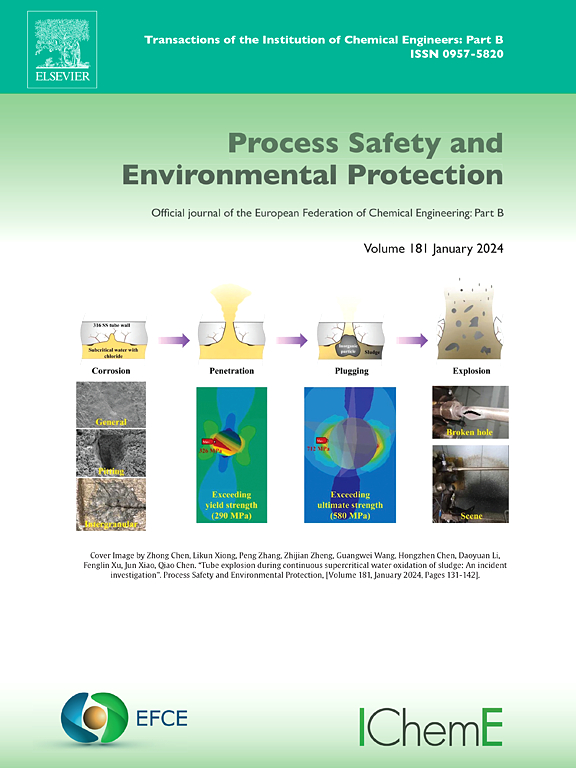Mg²⁺- Modified geopolymer induced struvite crystallization for nitrogen and phosphorus co-recovery and its synergistic lead immobilization
IF 6.9
2区 环境科学与生态学
Q1 ENGINEERING, CHEMICAL
引用次数: 0
Abstract
Nitrogen and phosphorus pollution-induced eutrophication and soil heavy metal contamination are two critical global environmental challenges. Struvite precipitation can not only simultaneously removes ammonia nitrogen (NH4+-N) and phosphate (PO43--P) from water but also generates struvite for heavy metal immobilization. However, the small crystalline particles generated causes the difficult collection of struvite. In this study, a MgCl2 modified metakaolin-based porous geopolymers (Mg2+-MKG) were prepared via a simple impregnation method and used as both magnesium source and crystal seed to induce the crystallization of struvite. The effects of MgCl2 content, adsorbent dosage, pH, nitrogen/phosphorus (N/P) ratio, and initial NH4+-N/PO43--P concentrations on adsorption capacity were systematically evaluated. The maximum adsorption capacities of 105.91 mg·g−1 (7.565 mmol·g−1) for NH4+-N and 168.05 mg·g−1 (5.421 mmol·g−1) for PO43--P were achieved under the optimal conditions: 0.4 g·L−1 20Mg2+-MKG dosage, pH= 8, N/P molar ratio 2.2:1, and initial NH4+-N/PO43--P concentrations of 100 mg·L−1. Kinetic and isothermal adsorption data for NH4+-N and PO43--P were well described by the pseudo-second-order and Langmuir models, respectively, indicating that this adsorption process was chemisorptive and spontaneous characteristics with exothermic behavior. NH4+-N adsorption mechanisms included physical adsorption, cation exchange between NH4+ and Mg2+, electrostatic interactions, and struvite formation, while PO43--P removal occurred predominantly via struvite precipitation. Additionally, the geopolymer/struvite composite generated as a byproduct during NH4+-N and PO43--P co-adsorption process exhibited superior Pb immobilization performance in contaminated soils.
Mg²+ -改性地聚合物诱导鸟粪石结晶,用于氮磷共回收及其协同固定化铅
氮磷污染引起的富营养化和土壤重金属污染是两大全球性环境挑战。鸟粪石沉淀不仅可以同时去除水中的氨氮(NH4+-N)和磷酸盐(PO43—P),还可以生成鸟粪石用于重金属的固定。然而,产生的小结晶颗粒导致鸟粪石难以收集。本研究采用简单浸渍法制备了MgCl2改性偏高岭土基多孔性地聚合物(Mg2+-MKG),并将其作为镁源和晶种诱导鸟粪石结晶。系统评价了MgCl2含量、吸附剂用量、pH、氮磷比和初始NH4+-N/PO43—P浓度对吸附能力的影响。在最佳条件下,NH4+-N和PO43—P的最大吸附量分别为105.91 mg·g−1(7.565 mmol·g−1)和168.05 mg·g−1(5.421 mmol·g−1),分别为20Mg2+-MKG用量0.4 g·L−1、pH= 8、N/P摩尔比2.2:1、初始NH4+-N/PO43—P浓度为100 mg·L−1。NH4+-N和PO43- P的动力学和等温吸附数据分别用拟二阶和Langmuir模型得到了很好的描述,表明该吸附过程具有化学吸附和自发的放热行为特征。NH4+-N的吸附机制包括物理吸附、NH4+与Mg2+阳离子交换、静电相互作用和鸟粪石的形成,而PO43—P的去除主要通过鸟粪石沉淀进行。此外,在NH4+-N和PO43—P共吸附过程中产生的副产物地聚合物/鸟粪石复合材料在污染土壤中表现出优异的Pb固定性能。
本文章由计算机程序翻译,如有差异,请以英文原文为准。
求助全文
约1分钟内获得全文
求助全文
来源期刊

Process Safety and Environmental Protection
环境科学-工程:化工
CiteScore
11.40
自引率
15.40%
发文量
929
审稿时长
8.0 months
期刊介绍:
The Process Safety and Environmental Protection (PSEP) journal is a leading international publication that focuses on the publication of high-quality, original research papers in the field of engineering, specifically those related to the safety of industrial processes and environmental protection. The journal encourages submissions that present new developments in safety and environmental aspects, particularly those that show how research findings can be applied in process engineering design and practice.
PSEP is particularly interested in research that brings fresh perspectives to established engineering principles, identifies unsolved problems, or suggests directions for future research. The journal also values contributions that push the boundaries of traditional engineering and welcomes multidisciplinary papers.
PSEP's articles are abstracted and indexed by a range of databases and services, which helps to ensure that the journal's research is accessible and recognized in the academic and professional communities. These databases include ANTE, Chemical Abstracts, Chemical Hazards in Industry, Current Contents, Elsevier Engineering Information database, Pascal Francis, Web of Science, Scopus, Engineering Information Database EnCompass LIT (Elsevier), and INSPEC. This wide coverage facilitates the dissemination of the journal's content to a global audience interested in process safety and environmental engineering.
 求助内容:
求助内容: 应助结果提醒方式:
应助结果提醒方式:


